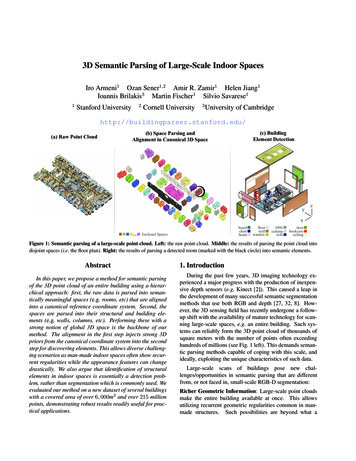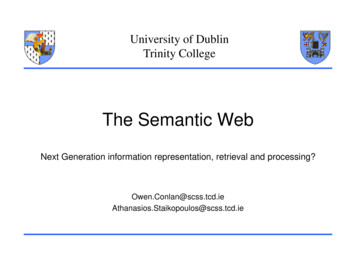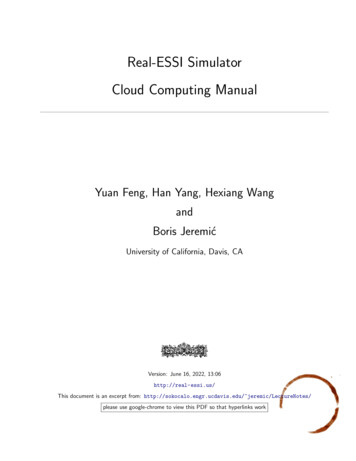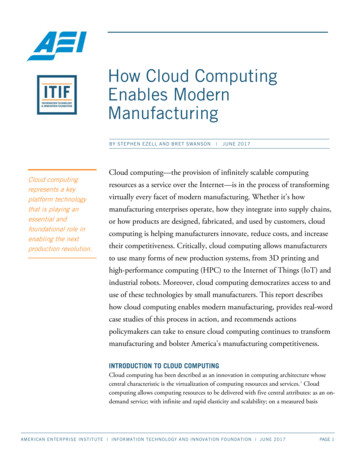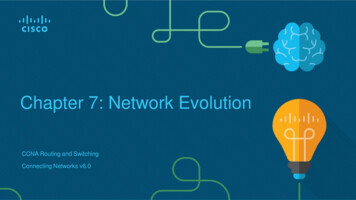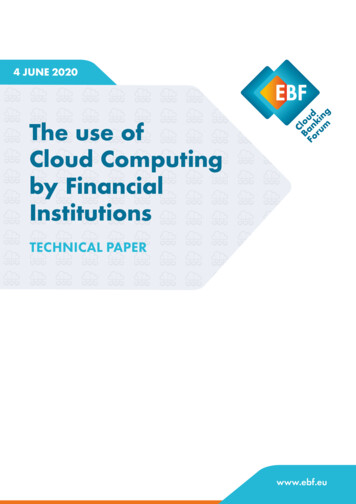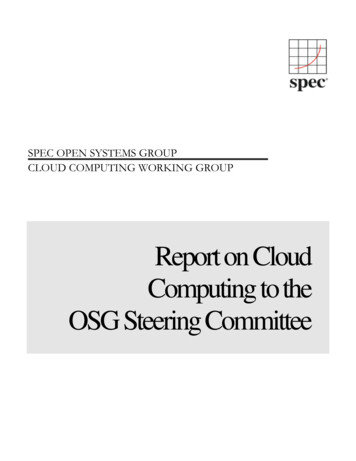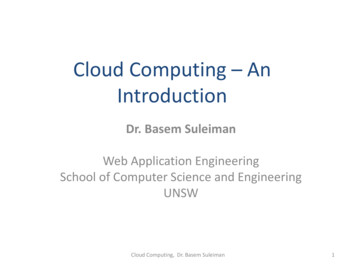
Transcription
Cloud Computing – AnIntroductionDr. Basem SuleimanWeb Application EngineeringSchool of Computer Science and EngineeringUNSWCloud Computing, Dr. Basem Suleiman1
The Internet - Web Applicationshttps://support.office.com/en-us/Cloud Computing, Dr. Basem Suleiman2
The Internet – Web Applications Web Applications drive the Internet–––––Email ApplicationsSocial Media/NetworkE-commerce ApplicationsWeb and data ServicesBusiness processes What makes such applications functional?– Hardware (Servers, Networks, Storage), Application and SystemSoftware, Databases system and software, etc.Sources: ive-and-engaging-facebook-posts/Cloud Computing, Dr. Basem Suleiman3
Web Hosting – Traditional ModelsSources: resources/what-is-cloud-hosting/Cloud Computing, Dr. Basem Suleiman4
Data Centers / Server Farms Collection of servers and computing devices that are networkedtogether and co-located into a single facility Servers can be configured and set up with appropriate systems andapplication software Major online companies have their own data centres, Google, eBay,Amazon An enterprise cloud have private date /i/story/60/98/011892/ebay-topaz-room1.jpgCloud Computing, Dr. Basem Suleiman5
Cloud Computing – Enabling TechnologiesCloud computing is the result of the evolution and adoption of existingtechnologies and paradigms Virtualization A software that separates a physical computing device into one or more virtualdevices, each of which can be easily used and managed to perform computingtasks Autonomic computing Automation of the process through which a user can provision resources ondemand Minimal user involvement, the automated process reduces costs and potentialhuman errors Service-Oriented Computing All resources in cloud computing model are provided as services Use of the well-established standards and best practices gained in the domain ofSOA to allow global and easy access to cloud services in a standardized wayCloud Computing, Dr. Basem Suleiman6
So, What’s Cloud Computing?“Cloudcomputing is a model for enabling convenient, ondemand network access to a shared pool of configurablecomputing resources (e.g., networks, servers, storage,applications, and services) that can be rapidly provisioned andreleased with minimal management effort or service providerinteraction.”(National Institute of Standards and Technology (NIST), USA). Note: there are many definitions and classification of cloud computing,it’s characteristics and modelsNIST definition and models are widely adopted in research andindustryCloud Computing, Dr. Basem Suleiman7
Cloud Computing – Essential CharacteristicsOn-demand self-service Computing capabilities, such as server and network storage, areprovisioned as needed automatically without requiring humaninteraction with each service providerBroad network access Capabilities are available over the network and accessed throughstandard mechanisms that promote use by heterogeneous thin or thickclient platformsResource pooling The provider’s computing resources are pooled to serve multipleconsumers using a multi-tenant model, with different physical andvirtual resources dynamically assigned and reassigned according toconsumer demandNIST definition of cloud computing cialpublication800-145.pdfCloud Computing, Dr. Basem Suleiman8
Cloud Computing – Essential CharacteristicsRapid elasticity Capabilities can be elastically provisioned and released, in some casesautomatically, to scale rapidly outward and inward commensurate withdemand To the consumer, the capabilities available for provisioning often appearto be unlimited and can be appropriated in any quantity at any time.Measured serviceCloud systems automatically control and optimize resource use byleveraging a metering capability at some level of abstraction appropriate tothe type of service (e.g., storage, processing, bandwidth, and active useraccounts)NIST definition of cloud computing cialpublication800-145.pdfCloud Computing, Dr. Basem Suleiman9
Cloud Computing – Service ModelsCloud Consumers / ClientsSoftware as a Service (SaaS)Platform as a Service (PaaS)Infrastructure as a Service (IaaS)Source: https://commons.wikimedia.org/w/index.php?curid 18327835Cloud Computing, Dr. Basem Suleiman10
Infrastructure as a Service (IaaS) Obtain basic computing resources such as processing, storage, networking, and associated software as services Enabled by virtualisation - running fully-functional independent virtualinstances on top of the actual physical infrastructure Processing - Virtual machines - VMWare, Xen, etc. Storage - Virtual Hard Disk over Distributed File Systems - NFS, GFS,Storage Pools, etc. Examples : Amazon, Rackspace, GoGrid (public and private cloudresources)Cloud Computing, Dr. Basem Suleiman11
Public Cloud Provider Example (IaaS)Amazon Web Services Amazon Elastic Compute Cloud (EC2) - Computing (VMs) Amazon Elastic Block Store (EBS) - Persistent block-level storage for EC2VMs Amazon RDS - Cloud-based RDBMS service Amazon Simple Storage Service (S3) - Storage Volumes Amazon CloudFront - Content delivery network that uses S3 to storeobjects in edge locations. Amazon Elastic LoadBalancer, CloudWatch Amazon DynamoDB - NoSQL database And many more Cloud Computing, Dr. Basem Suleiman12
Platform as a Service (PaaS) Allow users to develop and deploy applications on to a vendor'splatform using specific API/libraries that abstract the actual process Develop application in cloud-based environment Hardware details are hidden from the user - vendor takes care of theinfrastructure (could be IaaS) User has control over the hosting configurations and how muchapplication-level resources (objects, sessions, database tables) toconsume Pricing is also dependent on the application size Examples: Google App Engine, Microsoft Azure Services, Heroku, etc.Cloud Computing, Dr. Basem Suleiman13
Platform as a Service (PaaS) Allow users to develop and deploy applications on to a vendor'splatform using specific API/libraries that abstract the actual process Develop application in cloud-based environment Hardware details are hidden from the user - vendor takes care of theinfrastructure (could be IaaS) User has control over the hosting configurations and how muchapplication-level resources (objects, sessions, database tables) toconsume Pricing is also dependent on the application size Examples: Google App Engine, Microsoft Azure Services, Heroku, etc.Cloud Computing, Dr. Basem Suleiman14
Software as a Service (SaaS) Full-featured applications are delivered to the customer over theInternet No need to install the application locally Subscription model instead of upfront license and install model Some developer use APIs for integrating SaaS apps into internal apps Examples: Salesforce.com (CRM), Zoho (Collaboration),Cloud Computing, Dr. Basem Suleiman15
Cloud Computing – Deployment ModelsPrivate Cloud: The cloudinfrastructure is owned by a serviceprovider who makes it available to thegeneral publicfor commercial purposes.Public Cloud: The cloud infrastructureis owned by an organization whichoperates it only for its internal use.Hybrid Cloud: Combination of privateand public clouds. E.g. resourcessourced from public clouds wheneverdemandexceeds the capacity of a private cloud(cloud bursting), https://commons.wikimedia.org/w/index.php?curid 6089457NIST definition of cloud computing cialpublication800-145.pdfCloud Computing, Dr. Basem Suleiman16
Cloud Computing – Business ModelsOn understanding the economics and Elasticity Challenges of deploying business applications on public cloud ns/nictaabstracts/5536.pdfCloud Computing, Dr. Basem Suleiman17
Cloud Computing – Business ModelsPricing Models of AWS cloud servicesCloud Computing, Dr. Basem Suleiman18
Cloud Computing - Case StudyData-Intensive Application In 2007, The New York Times decided to make all public domain articlesfrom 1851 - 1922 available free of charge 11 million articles from 1885 - 1980 - each of which is composed of TIFFimages that have to be combined – hugely compute and data-intensive Solution - Use Amazon S3 to store the article data (4 TB) and EC2 machinesto generate the PDFs which were saved back to S3 from where they areserved Use Hadoop (open-source Map-Reduce implementation) for 1/self-service-prorated-super-computing-fun/? r 0Cloud Computing, Dr. Basem Suleiman19
Cloud Computing - Case StudyData-Intensive Application In 2007, The New York Times decided to make all public domain articlesfrom 1851 - 1922 available free of charge 11 million articles from 1885 - 1980 - each of which is composed of TIFFimages that have to be combined – hugely compute and data-intensive Solution - Use Amazon S3 to store the article data (4 TB) and EC2 machinesto generate the PDFs which were saved back to S3 from where they areserved Use Hadoop (open-source Map-Reduce implementation) for programming 100 EC2 instances Hadoop 24 hours Job Done! There are many high-performance data-intensive applications beingdeployed on cloud now - bioinformatics, data mining, image and 11/01/self-service-prorated-super-computing-fun/? r 0Cloud Computing, Dr. Basem Suleiman20
Elasticity – Cloud ComputingCloud Computing, Dr. Basem Suleiman21
Elasticity - Hosting Vs. IaaS Cloud On-demand computing resources – e.g., servers, storage Efficient use of resources – pay per usage time (pay-as-you-go)Source: On understanding the economics and elasticity challenges of deploying business applications on public cloudinfrastructure. J. Internet Services and Applications 3(2): 173-193 (2012)Cloud Computing, Dr. Basem Suleiman22
What is Elasticity (Auto-Scaling)? The ability of a system to dynamically adapt its underlyingcomputing infrastructure resources in response to variableworkload changes over time Can be at SaaS, PaaS, IaaS IaaS Elasticity– Adding/removing virtual or physical servers– Increasing/decreasing CPU, memory and storage capacity byadding/removing additional hardware components to existing machines– Increasing/decreasing network speed and number of IP addresses– Increasing/decreasing amount of data transfer and number of dataoperations/requests of cloud resources Manual (user interface) vs. automated means (APIs)– Auto-scalingCloud Computing, Dr. Basem Suleiman23
IaaS Elasticity and Web Applications Key characteristics of Web applications– Highly transactional - business value– Commodity - Variable workload patterns IaaS cloud– On-demand computing resources/services – pay-as-you-goCloud Computing, Dr. Basem Suleiman24
Case Study – Animoto AWS Elasticity Animoto an online video service, makes it easy to make andshare videos in just a few minutes The company launched in 2007 using its own servers, butmoved to AWS for additional capacity When Animoto integrated with Facebook in 2008, attracting750,000 new users in 3 days, it used AWS to handle the load.Animoto's Facebook scaling story on Amazon's Elastic Compute CloudCloud Computing, Dr. Basem Suleiman25
Cloud-based & Application-based SLA** Suleiman et. al. On Understanding The Economics and Elasticity Challenges of Deploying Business ApplicationsOn Public Cloud Infrastructure, JISA 2011Cloud Computing, Dr. Basem Suleiman26
Types of Scaling – Scaling ArchitectureCloud Computing, Dr. Basem Suleiman27
Horizontal vs. Vertical Scaling Horizontal (Scale-out and Scale-in)––––More computing resources (e.g., servers)Reliable – fail-over scenarioFully automatedGrowing management complexity Vertical (Scale-up and Scale-down)––––More powerful computing resources – bigger serversSingle point of failureHuman interventionReasonable management overheadCloud Computing, Dr. Basem Suleiman28
Horizontal vs. Vertical Scaling – Trade-offs* Suleiman et. al. On Understanding The Economics and Elasticity Challenges of Deploying Business ApplicationsOn Public Cloud Infrastructure, JISA 2011Cloud Computing, Dr. Basem Suleiman29
IaaS Elasticity (Auto-Scaling) Services AWS Elastic Load Balancing GoGrid’s Infrastructure and RAM Scaling Rackspace Cloud Monitoring and AWSCloudWatch AWS and Raclspace Auto Scaling RightScale cloud management platformCloud Computing, Dr. Basem Suleiman30
Elasticity Rules - ExamplesIaaS ServiceAuto Scaling RulesAmazon WebIf the application latency seen by the loadServices (AWS) balancer is greater than 800 millisecond for 9minutes continuously, scale out the applicationtierRackspace Auto If average memory utilization across all webScaleservers is greater than 85%, then scale out theweb serversCloud Computing, Dr. Basem Suleiman31
Elasticity (Auto-Scaling) Rules Rule-based mechanism– Monitor certain resources/application metrics– Determine when to trigger adding releasing computingresources– Determine how much computing resources toadd/release– Choose appropriate values for the core thresholds andparametersCloud Computing, Dr. Basem Suleiman32
Structure of Elasticity RulesCloud Computing, Dr. Basem Suleiman33
Auto-scaling Rules – ExampleMonitor CPU Utilization (CPUUtil) every 1 min. intervalIF CPUUtil 80% FOR 7 minutesAdd 1 server of small capacity//Scale-outWait 5 consecutive 1 min. intervalsIF CPUUtil 30% FOR 10 minutesRemove 1 server of small capacityWait 7 consecutive 1 min. intervalCloud Computing, Dr. Basem Suleiman//Scale-in34
AWS Elasticity (Auto-Scaling)Elastic LoadBalancerHasAuto-scalinggroupHasServer Config. ImageAssociated withAuto-scaling rulesScale-outAuto-scaling icAlarmAlarmHasCloud Computing, Dr. Basem SuleimanMetrics35
Guest Lecture 2Architecting for the CloudDr. Adenen GuabtniCloud Computing, Dr. Basem Suleiman36
So, What's Cloud Computing? Cloud Computing, Dr. Basem Suleiman 7 " Cloud computing is a model for enabling convenient, on-demand network access to a shared pool of configurable computing resources (e.g., networks, servers, storage, applications, and services) that can be rapidly provisioned and




